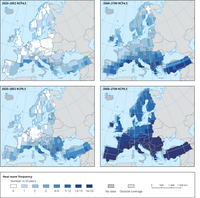
The top maps show the median of the number of heat waves in a multi-model ensemble of the near future (2020–2052) and the latter half of the century (2068–2100) under the RCP4.5 scenario, and the lower maps are for the same time periods but under RCP8.5

The delineation of European mountain areas was carried out by using digital elevation models, considering different criteria combination of thresholds of altitude, climate, and topography variables (IP2008 8.2.7 Regional and territorial development of mountain areas, ETC/LUSI - EEA). This dataset was created in 2008, covers the full European continent and is a reference layer for the EEA Report No 6/2010 on Europe's ecological backbone: recognising the true value of our mountain.

The present 100m raster datasets are the CORINE Land Cover status layers for 2000, 2006, 2012 and 2018, modified for the purpose of consistent statistical analysis in the land cover change accounting system at EEA.
CORINE Land Cover (CLC) data are produced from 1986 for European (EEA member or cooperating) countries. Altogether five mapping inventories were implemented in this period, producing five status layers (CLC1990, CLC2000, CLC2006, CLC2012, CLC2018) and four CLC-Change (CLCC) layers for the corresponding periods (1990-2000, 2000-2006, 2006-2012, 2012-2018). Pan-European CLC and CLCC data are available as vector and raster products.
Due to the technical characteristics of CLC and CLCC data, the evolution in CLC update methodology and in quality of input data, time-series statistics derived directly from historical CLC data includes several inconsistencies. In order to create a statistically solid basis for CLC-based time series analysis, a harmonization methodology was elaborated.


This database contain policies and measures (PaMs) reported by EU Member States following European Commission Implementing Decision (EU) 2018/1522 of 11 October 2018 laying down a common format for national air pollution control programmes under Directive (EU) 2016/2284 of the European Parliament and of the Council on the reduction of national emissions of certain atmospheric pollutants.

Potential quiet areas in Europe, based upon Quietness Suitability Index (QSI) and Natura 2000 protected areas

Northward shift of agro-climate zones in Europe analysed over the past 40 years and under future climate conditions for the next decades.

These maps show the trend in heating degree days (left) and cooling degree days (right) from 1981-2100 for all EEA member and cooperating countries, based on the median of an ensemble of 11 EURO-CORDEX simulations.

These maps show observed linear trends in heating degree days (left) and cooling degree days (right) over 1981–2017 for all EEA member and cooperating countries. Stippling depicts regions where the trend is statistically significant at the 5% level.

This map shows bathing water locations and their quality for the latest as well as previous bathing seasons. All symbols are coloured according to achieved quality status in the most recent season. Data are presented on two levels: country (less detailed scales) and bathing water (more detailed scales).